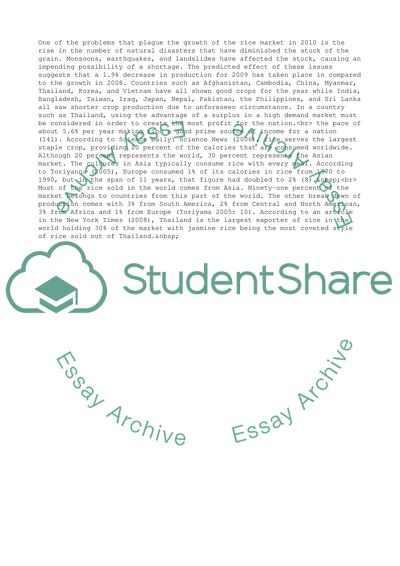Cite this document
(Rice: The Potential for this Commodity for the Future of Thailand Essay - 2, n.d.)
Rice: The Potential for this Commodity for the Future of Thailand Essay - 2. Retrieved from https://studentshare.org/business/1735339-there-is-an-expected-growth-of-rice-consumption-in-the-global-market-of-up-to-27-how-can-thailand-take-a-comparative-advantage-in-the-international-market-dissertationproject-proposal-plan
Rice: The Potential for this Commodity for the Future of Thailand Essay - 2. Retrieved from https://studentshare.org/business/1735339-there-is-an-expected-growth-of-rice-consumption-in-the-global-market-of-up-to-27-how-can-thailand-take-a-comparative-advantage-in-the-international-market-dissertationproject-proposal-plan
(Rice: The Potential for This Commodity for the Future of Thailand Essay - 2)
Rice: The Potential for This Commodity for the Future of Thailand Essay - 2. https://studentshare.org/business/1735339-there-is-an-expected-growth-of-rice-consumption-in-the-global-market-of-up-to-27-how-can-thailand-take-a-comparative-advantage-in-the-international-market-dissertationproject-proposal-plan.
Rice: The Potential for This Commodity for the Future of Thailand Essay - 2. https://studentshare.org/business/1735339-there-is-an-expected-growth-of-rice-consumption-in-the-global-market-of-up-to-27-how-can-thailand-take-a-comparative-advantage-in-the-international-market-dissertationproject-proposal-plan.
“Rice: The Potential for This Commodity for the Future of Thailand Essay - 2”, n.d. https://studentshare.org/business/1735339-there-is-an-expected-growth-of-rice-consumption-in-the-global-market-of-up-to-27-how-can-thailand-take-a-comparative-advantage-in-the-international-market-dissertationproject-proposal-plan.


